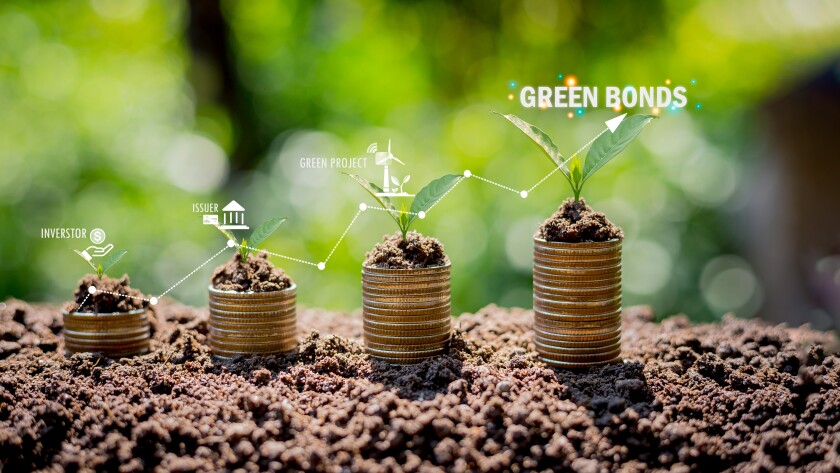1 Introduction
Bonds that raise funds for projects aimed at solving environmental and social issues are called ESG bonds, and, among these, those that focus on the use of proceeds for environment-related projects are called ‘green bonds’. Green bond issuance in Japan is conducted in accordance with International Capital Market Association (ICMA) principles and guidelines issued by the Ministry of the Environment.
In addition, in projects subsidised to support green finance implemented by the ministry, the framework of green bonds, sustainability bonds with green characteristics, and sustainability-linked bonds that are eligible for subsidies are required to comply with the guidelines issued by the Ministry of the Environment.
2 Green bonds
The Ministry of the Environment published the Green Bond Guidelines, 2017 in March 2017 and the Green Bond and Sustainability-Linked Bond Guidelines 2022 (GBSLBG) in July 2022 to be consistent with revised international principles.
The GBSLBG is designed to maintain the ‘social’ aspect of the ‘greenness’ of green bonds and to prevent bonds over which there are worries about greenwashing from being floated on the market, by providing examples of what is expected of green bonds and interpretations in line with domestic characteristics, while considering consistency with the ICMA’s Green Bond Principles (GBP). However, the GBSLBG is legally non-binding and no legal penalties will be imposed even if an action does not comply with the guidelines.
The GBSLBG defines green bonds as “bonds issued to raise funds for eligible domestic and overseas Green Projects. Specifically, these bonds have the following features: (i) the proceeds, or an equivalent amount, will be exclusively allocated to eligible Green Projects, (ii) proceeds are tracked and managed in a reliable manner, and (iii) transparency is ensured by reporting after the issuance of the bonds.”
The GBSLBG recognises that bonds that align with all the elements that are described with the word “should” with regard to the four components of (i) use of proceeds, (ii) process for project evaluation and selection, (iii) management of proceeds, and (iv) reporting (the "core components of green bonds") can be internationally accepted as green bonds. In addition, the GBSLBG recognises that addressing two of the key recommendations, green bond frameworks and external reviews (also described with the word “should”), would also contribute to improving the transparency of green bonds, which the ICMA Green Bond Principles emphasises.
The following items are described with the word “should” with respect to the “core components of a green bond” under the GBSLBG.
2.1 Use of proceeds
Under the GBSLBG, the proceeds raised by green bonds should be used for eligible “green projects” that have clear environmental benefits. Issuers should provide investors, in advance, with information regarding the use of green bond proceeds through legally required documents (such as a prospectus) or other documents. Communications with investors on the use of proceeds should specify the project category of the green project.
In cases where green projects have associated negative environmental and/or social risks along with the intended environmental benefits, issuers should include information such as these negative impacts (e.g., the assessment results and how the issuer will address them) when communicating with investors on the use of proceeds.
When green bonds are issued multiple times to refinance for an asset that requires long-term maintenance, the issuer should:
Clearly disclose the asset’s age, its remaining useful life, and the amount to be refinanced, as at the time of the bond issuance;
Evaluate the long-term sustainability of environmental benefits; and
Obtain an assessment from an external reviewer as necessary.
2.2 Process of project evaluation and selection
The issuer should communicate to investors in advance its environmental sustainability objectives (the environmental benefits it intends to achieve through the green bond).
Issuers should explain to investors in advance the criteria; i.e., the basis for their decisions in evaluating and selecting a project in light of its “environmental sustainability objectives”.
The GBSLBG also states that the process should be explained to investors in advance; e.g., “the basis for how issuers determine why certain projects can provide environmental benefits appropriately in light of the objectives and criteria for the use of Green Bond proceeds” and “how and by whom the above criteria are applied and used to determine whether Green Projects are eligible in light of the environmental objectives”.
Issuers should provide investors with additional information in advance about the “the process by which the issuer identifies, mitigates and manages the perceived environmental and social risks associated with the relevant project(s)” (i.e., identification, mitigation, and management of significant environmental and/or social negative impacts, as well as the environmental and social risks associated with the implementation of the project).
2.3 Management of proceeds
The issuer should track and manage the entire amount of proceeds in an appropriate manner. These tracking and managing activities should be controlled by the issuer’s internal process.
As long as the green bonds are outstanding, the issuer should conduct periodic checks (at least annually) to ensure that the amount allocated to green projects is equal to, or greater than, the amount raised by the issuance of the green bonds, or that the sum of the amount allocated to green projects and the amount of unallocated funds matches the total amount of green bonds proceeds.
If any of the proceeds remain temporarily unallocated, the issuer should explain to the investors how it intends to manage the balance of such unallocated funds, and endeavour to allocate the unallocated funds to green projects as soon as possible.
Issuers should communicate to investors, in advance, how green bond proceeds will be tracked and managed, and how unallocated funds will be managed.
2.4 Reporting
Issuers should publicly disclose up-to-date information on the use of proceeds from green bonds and post it in places (including on websites such as homepages) easily accessible to investors.
Up-to-date information should be disclosed on the use of proceeds, at least annually, and in the case of material developments, until full allocation. Issuers should disclose the information in a timely manner even after all the proceeds are allocated in the case of material developments.
The above disclosures should include the following items:
A list of the green projects to which green bond proceeds have been allocated;
A brief description of each green project (including up-to-date progress);
The amount allocated to each green project;
The expected environmental benefits of each green project;
In the event that there are unallocated green bond proceeds, the amount or proportion of such unallocated proceeds, the expected timing of allocation, and how the unallocated proceeds will be managed until allocation.
With regard to disclosures concerning the expected environmental benefits of projects, issuers should use appropriate indicators while ensuring consistency with the characteristics of green projects.
The recommendations described with the word “should” for the key recommendations under the GBSLBG are as follows.
2.5 Green bond framework
Issuers should explain the alignment of the green bond or green bond programme with the four core components (use of proceeds, process for project evaluation and selection, management of proceeds, and reporting), in a green bond framework or in their legally required documents, such as the prospectus. Issuers should make these documents available in a readily accessible format to investors (such as on a website).
2.6 External reviews
Issuers should disclose documents relating to the review results when, and if, issuers obtain external reviews for their green bonds.
External reviewers should follow the following codes of conduct when giving reviews:
Integrity;
Fairness;
Abilities and due care as professionals;
Duty of confidentiality; and
Actions as professionals.
External reviewers should have a sufficient organisational structure to appropriately undertake external reviews and employ a reasonable number of people who have the professional experience and qualifications necessary to cover the areas subject to the external reviews to be conducted. In addition, when using liability insurance concerning specialist areas, external review providers should note the coverage scope of the insurance.
External reviewers should evaluate the following content, depending on the type of external review:
The intended environmental benefits of the green project for which the funds are to be used;
Alignment with the four elements expected of green bonds; and
Any potentially significant environmental and social risks associated with green projects as identified by the issuer, and the process for identifying, mitigating, and managing them.
External reviewers should include a general description of the purpose of an external review, the scope of the review, the qualifications of the persons who will be conducting the external review, and their expertise as external reviewers.
External reviewers should include, in documents and material concerning their review results, a statement on their independence and their policy on conflicts of interest. They should clearly explain the evaluation criteria applied to respective items in the documents and materials concerning their review results.
A conclusion and an output should be included in an external review, including the limitations of assessments made in external reviews .
2.7 Guidance on the eligibility of a green project that has clear environmental benefits
The GBSLBG states that the environmental benefits of a green project should be evaluated by the issuer, and that the final decision on how to evaluate the appropriateness of the issuer’s approach is left to the market. From the perspective of improving the usefulness of the guidelines for a wider range of those seeking financing, the GBSLBG has clarified the criteria for determining ‘greenness’ in the July 2022 revision (provided that the GBSLBG can only be used as a reference in determining clear environmental benefits, and not all the criteria must be met for a project to be considered green).
Based on the GBP's categorisation of examples of use of proceeds, the GBSLBG also includes a list of items that can be classified as green projects in Japan, including examples of their use of proceeds, evaluation indicators (KPIs), and negative effects, in light of the situation in Japan.
The GBSLBG provides the following examples that issuers may refer to in the preliminary evaluation of whether an eligible green project has clear environmental benefits:
It can be logically explained that the output of the project will lead to achieving the intended environmental objectives (positive impact) of the green bond;
It is objectively evident that environmental benefits will be generated through the project implementation; for example, the indicator(s) for measuring environmental benefits is/are expected to improve in comparison with a ‘business as usual’ (without project implementation) trajectory, or the project is expected to clearly produce environmental benefits in light of socioeconomic conditions, such as the introduction of renewable energy facilities in the field of climate change mitigation;
Where a long-term goal exists in relation to the environmental objectives to be achieved through the project implementation – at the global level, or at the country, region, or sector level where the fundraiser is located or where the project is implemented (e.g., Japan’s 2050 carbon neutrality goal) – there is consistency between the project and the achievement of these long-term objectives in principle, and there is no apparent inconsistency; and
The project has a process by which its associated negative impacts besides its intended environmental benefits are identified, mitigated, and managed.
3 Sustainability bonds
In sustainability bonds, all proceeds are used solely for the initial investment or refinancing of green projects or social projects. The GBSLBG focuses on ‘green characteristics’ related to sustainability bonds that include green projects as a use of funds and is applied not only to green bonds but also to green characteristics related to sustainability bonds. Accordingly, the GBSLBG is applicable to sustainability bonds with green characteristics.
4 Platform for ESG bonds listed on the Tokyo Pro-Bond Market
In light of the growing issuance of, and investment in, green bonds and social bonds in Japan, the Tokyo Stock Exchange has established a platform on its website where issuers can post information on ESG bonds, including green bonds.
If an issuer of a bond listed on the Tokyo Pro-Bond Market operated by the exchange wishes to post relevant information on an ESG bond, upon application by the issuer, the issuer may post “Use of Proceeds,” “External Review,” “Reporting”, and “Related Information” (such as press releases by the issuer and investment targets) on the platform established by the exchange.


